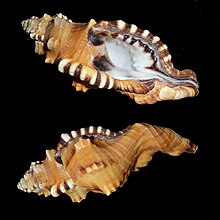Lotoria lotoria
| Lotoria lotoria Temporal range:
| |
|---|---|

| |
| A shell of Lotoria lotoria with the periostracum removed | |
| Scientific classification | |
| Domain: | Eukaryota |
| Kingdom: | Animalia |
| Phylum: | Mollusca |
| Class: | Gastropoda |
| Subclass: | Caenogastropoda |
| Order: | Littorinimorpha |
| Family: | Cymatiidae |
| Genus: | Lotoria |
| Species: | L. lotoria
|
| Binomial name | |
| Lotoria lotoria (Linnaeus, 1758)
| |
| Synonyms | |
| |
Lotoria lotoria, common name the black-spotted snail or washing bath triton, is a species of predatory sea snail, a tropical marine gastropod mollusc in the family Cymatiidae. This species was previously known as Cymatium lotorium.[2]
Fossil records
[edit]
Fossils from this family date back to the Eocene (age range: from 55.8 to 0.012 million years ago).[3]
Description
[edit]Shells of Lotoria lotoria can reach a size of 90–160 millimetres (3.5–6.3 in).[4][5]
The shell is somewhat fusiformly turreted, thick, solid, distorted at the lower part, with four or five varices. The spire is rude and rather obtuse. The whorls are angulated at the upper part, obsoletely depressly ribbed with the ribs crenulated. The shell is reddish yellow, ornamented above the aperture and upon the varices between the ribs with blackish brown. The columella is more or less obsoletely plaited. The outer lip is denticulated. The siphonal canal is short and broad.[6]
Distribution
[edit]This species of marine snail lives in the tropical Indo-Pacific oceans,[5][7] the Philippines, Papua New Guinea, the Marquesas Islands and off Australia (Queensland)
Habitat
[edit]Lotoria lotoria is quite common in coral reefs in Australia and the Indian Ocean.
References
[edit]- ^ WMSDB
- ^ Lotoria lotoria (Linnaeus, 1758). Retrieved through: World Register of Marine Species on 6 December 2018.
- ^ Taxon 9721; Fossilworks
- ^ Cymatium lotorium; on Jaxshells online
- ^ a b "Lotoria lotoria". Gastropods.com. Retrieved 12 January 2019.
- ^ Reeve, L. A. (1844). Monograph of the genus Triton. In: Conchologia Iconica, or, illustrations of the shells of molluscous animals, vol. 2, pls 1-20 and unpaginated text. L. Reeve & Co., London.
- ^ Discover life
- Lamarck J.B. (1816). Liste des objets représentés dans les planches de cette livraison. In: Tableau encyclopédique et méthodique des trois règnes de la Nature. Mollusques et Polypes divers. Agasse, Paris. 16 pp.
- Röding, P.F. 1798. Museum Boltenianum sive Catalogus cimeliorum e tribus regnis naturae quae olim collegerat Joa. Hamburg : Trappii 199 pp.
- Allan, J.K. 1950. Australian shells: with related animals living in the sea, in freshwater and on the land. Melbourne : Georgian House xix, 470 pp., 45 pls, 112 text figs.
- Satyamurti, S.T. 1952. Mollusca of Krusadai Is. I. Amphineura and Gastropoda. Bulletin of the Madras Government Museum, Natural History ns 1(no. 2, pt 6): 267 pp., 34 pls [141, pl. 12,
- Rippingale, O.H. & McMichael, D.F. 1961. Queensland and Great Barrier Reef shells. Brisbane : Jacaranda Press 210 pp.
- Beu, A.G. 1969. Murex lotorium Linnaues, 1758 (Mollusca, Gastropoda): request for validation in its accustomed sense under the plenary powers. Z.N.(S). 1886. Bulletin of Zoological Nomenclature 26(3): 174-176
- Wilson, B.R. & Gillett, K. 1971. Australian shells: illustrating and describing 600 species of marine gastropods found in Australian waters. Sydney : Reed Books 168 pp.
- Hinton, A. 1972. Shells of New Guinea and the central Indo-Pacific. Milton : Jacaranda Press xviii 94 pp.
- Salvat, B. & Rives, C. 1975. Coquillages de Polynésie. Tahiti : Papéete Les editions du pacifique, 391 pp.
- Coleman, N. 1975. What Shell is That? Sydney : Lansdowne Press 298 pp.
- Drivas, J.; Jay, M. (1987). Coquillages de La Réunion et de l'Île Maurice. Collection Les Beautés de la Nature. Delachaux et Niestlé: Neuchâtel. ISBN 2-603-00654-1. 159 pp
- Henning, T. & Hemmen, J. 1993. Ranellidae and Personidae of the World. Wiesbaden, Germany : V.C. Hemmen 263 pp.
- Wilson, B. 1993. Australian Marine Shells. Prosobranch Gastropods. Kallaroo, Western Australia : Odyssey Publishing Vol. 1 408 pp.
- Beu, A.G. 1998. Indo-West Pacific Ranellidae, Bursidae and Personidae. A monograph of the New Caledonian fauna, with revisions of related taxa. Mémoires du Muséum national d'Histoire naturelle, Paris [1936-1950] 178: 1-256
- Liu J.Y. [Ruiyu] (ed.). (2008). Checklist of marine biota of China seas. China Science Press. 1267 pp
- Tröndlé, J. & M. Boutet 2009. Inventory of marine molluscs of French Polynesia. Atoll Research Bulletin 570: 1-87
- Severns, M. 2011. Shells of Hawaiian Islands: the sea shells. The verifiable species and their described variants illustrated by 2828 images on 225 plates. Hachenheim, Germany : ConchBooks.
- Beu, A.G., Bouchet, P. & Tröndlé, J. 2012. Tonnoidean gastropods of French Polynesia. Molluscan Research 32(2): 61-120
External links
[edit]- Linnaeus, C. (1758). Systema Naturae per regna tria naturae, secundum classes, ordines, genera, species, cum characteribus, differentiis, synonymis, locis. Editio decima, reformata. Laurentius Salvius: Holmiae. ii, 824 pp
- Conchology
- Emerson W.K. & Old W.E. (1963). A new subgenus and species of Cymatium (Mollusca, Gastropoda). American Museum Novitates. 2137: 1–13
Text is available under the CC BY-SA 4.0 license; additional terms may apply.
Images, videos and audio are available under their respective licenses.
